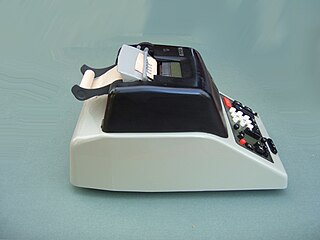
Industrial design is a process of design applied to physical products that are to be manufactured by mass production. It is the creative act of determining and defining a product's form and features, which takes place in advance of the manufacture or production of the product. Industrial manufacture consists of pre-determined, standardized and repeated, often automated, acts of replication, while craft-based design is a process or approach in which the form of the product is determined personally by the product's creator largely concurrent with the act of its production.

Usability can be described as the capacity of a system to provide a condition for its users to perform the tasks safely, effectively, and efficiently while enjoying the experience. In software engineering, usability is the degree to which a software can be used by specified consumers to achieve quantified objectives with effectiveness, efficiency, and satisfaction in a quantified context of use.
Creative problem-solving (CPS) is the mental process of searching for an original and previously unknown solution to a problem. To qualify, the solution must be novel and reached independently. The creative problem-solving process was originally developed by Alex Osborn and Sid Parnes. Creative problem solving (CPS) is a way of using creativity to develop new ideas and solutions to problems. The process is based on separating divergent and convergent thinking styles, so that one can focus their mind on creating at the first stage, and then evaluating at the second stage.
User-centered design (UCD) or user-driven development (UDD) is a framework of process in which usability goals, user characteristics, environment, tasks and workflow of a product, service or process are given extensive attention at each stage of the design process. These tests are conducted with/without actual users during each stage of the process from requirements, pre-production models and post production, completing a circle of proof back to and ensuring that "development proceeds with the user as the center of focus." Such testing is necessary as it is often very difficult for the designers of a product to understand intuitively the first-time users of their design experiences, and what each user's learning curve may look like. User-centered design is based on the understanding of a user, their demands, priorities and experiences and when used, is known to lead to an increased product usefulness and usability as it delivers satisfaction to the user.
Product design as a verb is to create a new product to be sold by a business to its customers. A very broad coefficient and effective generation and development of ideas through a process that leads to new products. Thus, it is a major aspect of new product development.
Software prototyping is the activity of creating prototypes of software applications, i.e., incomplete versions of the software program being developed. It is an activity that can occur in software development and is comparable to prototyping as known from other fields, such as mechanical engineering or manufacturing.
Iterative design is a design methodology based on a cyclic process of prototyping, testing, analyzing, and refining a product or process. Based on the results of testing the most recent iteration of a design, changes and refinements are made. This process is intended to ultimately improve the quality and functionality of a design. In iterative design, interaction with the designed system is used as a form of research for informing and evolving a project, as successive versions, or iterations of a design are implemented.
Service design is the activity of planning and arranging people, infrastructure, communication and material components of a service in order to improve its quality, and the interaction between the service provider and its users. Service design may function as a way to inform changes to an existing service or create a new service entirely.

Conceptual economy is a term describing the contribution of creativity, innovation, and design skills to economic competitiveness, especially in the global context.
Design thinking refers to the set of cognitive, strategic and practical procedures used by designers in the process of designing, and to the body of knowledge that has been developed about how people reason when engaging with design problems.
Lead user is a term developed by American economist Eric von Hippel. His definition for lead user is:
- Lead users face needs that will be general in a marketplace – but face them months or years before the bulk of that marketplace encounters them, and
- Lead users are positioned to benefit significantly by obtaining a solution to their needs and so may innovate.
Social design is the application of design methodologies in order to tackle complex human issues, placing the social issues as the priority. Historically social design has been mindful of the designer's role and responsibility in society, and of the use of design processes to bring about social change. Social design as a discipline has been practiced primarily in two different models, as either the application of the human-centered design methodology in the social sector or governmental sector, or sometimes is synonymously practiced by designers who venture into social entrepreneurship.
The engineering design process, also known as the engineering method, is a common series of steps that engineers use in creating functional products and processes. The process is highly iterative – parts of the process often need to be repeated many times before another can be entered – though the part(s) that get iterated and the number of such cycles in any given project may vary.
User experience design defines the experience a user would go through when interacting with a company, its services, and its products. User experience design is a user centered design approach because it considers the user's experience when using a product or platform. Research, data analysis, and test results drive design decisions in UX design rather than aesthetic preferences and opinions. Unlike user interface design, which focuses solely on the design of a computer interface, UX design encompasses all aspects of a user's perceived experience with a product or website, such as its usability, usefulness, desirability, brand perception, and overall performance. UX design is also an element of the customer experience (CX), and encompasses all aspects and stages of a customer's experience and interaction with a company.
Contextual design (CD) is a user-centered design process developed by Hugh Beyer and Karen Holtzblatt. It incorporates ethnographic methods for gathering data relevant to the product via field studies, rationalizing workflows, and designing human–computer interfaces. In practice, this means that researchers aggregate data from customers in the field where people are living and applying these findings into a final product. Contextual design can be seen as an alternative to engineering and feature driven models of creating new systems.
In requirements engineering, requirements elicitation is the practice of researching and discovering the requirements of a system from users, customers, and other stakeholders. The practice is also sometimes referred to as "requirement gathering".
Human-centered design is an approach to problem-solving commonly used in process, product, service and system design, management, and engineering frameworks that develops solutions to problems by involving the human perspective in all steps of the problem-solving process. Human involvement typically takes place in initially observing the problem within context, brainstorming, conceptualizing, developing of concepts and implementing the solution.
Human-centered design is an approach to interactive systems development that aims to make systems usable and useful by focusing on the users, their needs and requirements, and by applying human factors/ergonomics, and usability knowledge and techniques. This approach enhances effectiveness and efficiency, improves human well-being, user satisfaction, accessibility and sustainability; and counteracts possible adverse effects of use on human health, safety and performance.
The idea of technology brokering is to span multiple industries, and to see how existing technologies could be used to create breakthrough innovations in other markets. Technology brokering requires companies to be strong in two areas. As Andrew Hargadon, technology brokering's founder, summarized: "Firstly, the company must have the ability to bridge distant communities, usually when a company can move easily across a range of different markets they have a better view of how technologies can be used in new ways. Secondly, technology brokering involves creating new markets and industries from innovative combinations of existing technology. These two strengths are difficult to have simultaneously because the strong ties the companies have with customers and supplies in one industry prevent the company from moving easily into other markets and experimenting with new ideas."
Toolkits for user innovation and custom design are coordinated sets of “user-friendly” design tools. They are designed to support users who may wish to develop products or services for their own use. The problem toolkits are developed to solve is that, while user designers may know their own needs better than do producers, their technical design skills may be less than those of producer-employed developers. For example, expert users of tennis rackets – or expert users of custom integrated circuits – generally know more than producers do about the function they want a product to serve. However, they are often not as good as producer engineers at actually designing the product they need.
Design prototyping in its broader definition comprises the actions to make, test and analyse a prototype, a model or a mockup according to one or various purposes in different stages of the design process. Other definitions consider prototyping as the methods or techniques for making a prototype, or a stage in the design process. The concept of prototyping in design disciplines' literature is also related to the concepts of experimentation, and Research through Design (RtD).


